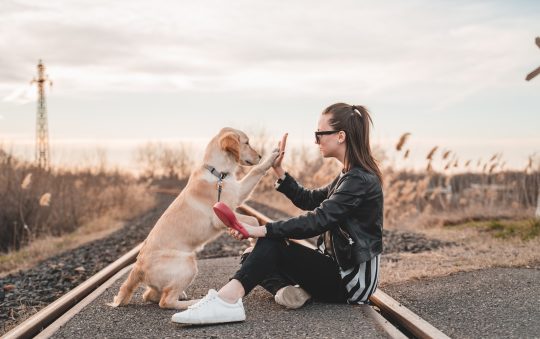Why Understanding Dog Body Language is Important
We all love our furry companions, but sometimes they can be a mystery to us. Have you ever wondered what your dog is trying to communicate through their body language? Understanding your dog’s non-verbal cues can improve your relationship and help you meet their needs. In this article, we’ll explore the different signals and behaviors that dogs use to communicate with us.
By learning how to interpret your dog’s facial expressions, tail position, ear position, body posture, and vocalizations, you’ll gain valuable insights into their thoughts and emotions. We’ll also cover common misunderstandings between dogs and owners and provide tips for solving them.
Whether you’re a new dog owner or a seasoned pro, this article is for you. Our goal is to help you better understand your furry friend and deepen your bond. So grab a cup of coffee, sit back, and let’s dive into the fascinating world of dog body language.
Facial Expressions
Facial expressions can tell us a great deal about how a dog is feeling and what they’re trying to communicate. We often overlook facial expressions as a way to understand our canine companions, but they are an important part of communication. When we pay attention to the subtle nuances of our pup’s face, we can pick up on subtle signals that can help us better understand our furry friends.
A dog’s facial expressions can be broken down into two main categories: relaxed and tense. When a pup’s face is relaxed, their eyes will be open, perhaps with a slight squint, and their mouth hangs open with their tongue slightly visible. This is usually how a happy pup expresses themselves, showing contentment and relaxation. On the other hand, when a pup is tense or feeling scared, their eyes will be wide open with their eyebrows slightly raised. Their mouth may also be tightly shut with their lips pulled back and no tongue visible.
In addition to these two main facial expressions, there are other subtle cues that can help us identify specific emotions such as fear and aggression. For example, when a dog is feeling scared or threatened, they may pull their ears back and tuck their tail close to their body. Aggressive dogs may flatten their ears against their head and pull back the corners of their mouths slowly in an attempt to appear more intimidating.
By understanding the facial expressions of our pups, we can better interpret how they’re feeling and what they’re trying to communicate. It’s important to keep in mind that context is key here – the same facial expression can mean different things depending on the situation. For example, a pup may show wide eyes when they’re scared or excited – so it’s important to take into account what other body language cues they’re displaying as well.
If you find yourself having difficulty deciphering facial expressions, try talking to your pup in a soothing tone or offering treats as rewards for good behavior. This will help them feel more comfortable around you and give you an opportunity to observe how they react to different situations. With patience and practice, you’ll soon be able to read your pup like a book!
Tail Position
Tail position is one of the most important signals a dog can communicate with. A wagging tail is often seen as a sign of happiness and friendliness, while a tail tucked between the legs might indicate fear or stress. It’s important to understand these signals and how they relate to other body positions in order to understand your dog’s behavior.
Tails come in all shapes, sizes, and positions, and each one can tell you something about the emotional state of your pup. A tail held high with its tip curved up is often a sign of confidence and curiosity. If the tail is low and wagging, it could mean your pup is happy or excited to see you. On the other hand, a rapidly wagging tail can sometimes indicate aggression or fear. The key is to look at the context – if the body posture is stiff and aggressive, then the wagging tail is likely communicating that your pup is feeling defensive or ready to fight.
When a dog tucks their tail between their legs, it usually indicates fear or submission. This position might be accompanied by other body language signals such as trembling and cowering. The tail may also be tucked tightly against their body, which can be a sign that they’re feeling anxious or trying to hide.
The relationship between tail position and overall body posture can help you further interpret what your pup is feeling. For example, if a dog has a relaxed body posture but their tail is tucked between their legs, it could mean that they’re uncertain about a specific situation or person. On the other hand, if their body posture is stiff and tense but their tail is held high and wagging, then it could mean your pup feels threatened but is trying to show confidence.
Understanding your pup’s tail movements can give you an insight into what they’re thinking and feeling. Paying attention to changes in tail position in relation to body posture can help you better interpret their behavior so you can respond appropriately to any given situation.
Ear Position
Reading your dog’s body language is a key part of understanding how they communicate and act. Ear position is one of the most important elements to look for when trying to decode canine behavior. Knowing the different ear positions a dog has and what they mean can help you better interpret your pup’s actions and emotions.
The position of your dog’s ears can tell you a lot about how they’re feeling in any given moment. Ears that are perked up, standing straight up and facing forward, often indicate that your pup is in a relaxed, alert state. If the ears are pulled back and against the head, this could indicate fear or submission. Droopy ears and those pushed forward can signify curiosity or attentiveness. It’s important to take into account the overall body posture of your pup as well to make sure you’re correctly reading their ear position in context.
The way your dog’s ears move is also an important part of understanding their emotions and intentions. For example, if your pup’s ears are twitching or shaking this could signal either discomfort or excitement depending on the other body language signs they’re exhibiting. Some dogs may jerk their heads when they hear something unfamiliar or unexpected. This could be a sign of surprise or curiosity, or it could be a sign of displeasure or anxiety.
In some cases, dogs may tilt their heads to one side when they’re listening closely or trying to understand something. This head tilt may be accompanied by other behaviors such as panting, licking their lips, or even staring directly at you. In these situations, it’s best to remain calm and reassuring so as not to scare your pup away with any sudden movements or loud noises.
Knowing the meaning behind different ear positions and movements can help you better read your pup’s behavior and interpret their needs in any given situation. Remember to take into account the other body language cues your pup is exhibiting so you can make sure you’re correctly interpreting their message.
Body Posture
Understanding a dog’s body posture is one of the most important parts of understanding their behavior. By looking at their posture, you can determine how they’re feeling, as well as how they’re likely to act in a given situation. From a relaxed, happy stance to a fearful, defensive one, each body position has its own unique meaning.
The most obvious sign of a relaxed posture is when a dog is lying on its side or back with its legs extended. This indicates a dog is feeling safe and secure. On the other hand, an anxious or fearful dog may show signs of tension like crouching down or tucking its tail between its legs. Dogs also display a “playful” stance when they’re excited, which usually involves them standing on their hind legs and wagging their tails.
It’s important to look at the whole picture when interpreting a dog’s body language. Take into account all of the signals they’re giving off before making any assumptions. For instance, if your dog is standing upright with his ears pricked up and tail wagging, he could be feeling excited and ready to play. But if his tail is tucked between his legs and he’s avoiding eye contact, he may be feeling scared and uncertain about a situation.
In addition to body position, look for other signals like facial expressions and vocalizations to get a better understanding of how your dog is feeling. In some cases, these subtler cues can be more telling than the posture itself. For example, if your dog is displaying a relaxed body stance but has furrowed eyebrows or bared teeth, this could be a sign of aggression or fear.
By taking the time to observe your dog’s body language and read into the subtler cues they give off, you will have an easier time understanding their feelings and reactions to different situations. With patience and practice, you can become an expert in your pup’s unique communication style.
Vocalizations
Dogs use vocalizations as a powerful means of communication, with each sound conveying its own message. As owners, it’s important to pay attention to the type and context of each vocalization our pup makes to understand their communication.
Barking is the most common type of vocalization and usually indicates excitement or alarm. It can range from a single “woof” to many barks in quick succession, but all of them mean “pay attention to me!” A low-pitched bark indicates aggression or territoriality, while a high-pitched bark usually indicates fear. Dogs may also bark when they want to get your attention or play.
Growling is another type of vocalization that often indicates aggression or fear, and should be taken seriously. It can be difficult to distinguish between fearful growling, where a dog is trying to get away from something, and aggressive growling, where a dog is trying to confront something. Pay attention to your pup’s body language and recognize other signs like stiffening or raising of the hackles if they are growling aggressively.
Whining is typically a sign of distress or discomfort, especially when accompanied by pacing or circling. A soft whimper can also indicate fear or anxiety and should be addressed accordingly. To help ensure your pup’s safety and well-being, it’s important to take notice of any whining and determine if there’s a potential cause for concern.
It’s also important to note that vocalizations are not isolated events — a pup’s body language should be taken into account when interpreting their sounds. A bark that may seem aggressive in one context could be interpreted as playful in another depending on the accompanying posture and facial expressions. Likewise, growling that may seem playful at first could turn serious if accompanied by certain body postures.
By paying attention to your pup’s vocalizations and other non-verbal cues together, you can gain a better understanding of their communication signals and act accordingly. This helps ensure the safety of everyone involved and builds trust between you and your pup.
Common Misunderstandings and Solutions
Misunderstanding dog body language can cause confusion and frustration for both pets and owners. It is important to recognize common misunderstandings and learn strategies for solving them.
One common misunderstanding is the interpretation of aggressive behavior. While dogs may bare their teeth or growl when feeling threatened, these behaviors are not always a sign of aggression. Oftentimes, dogs will bare their teeth in a defensive stance, as a sign of warning. Understanding the context of these behaviors is key to understanding the dog’s intentions.
Another common misunderstanding is tail wagging. While it is often assumed that a wagging tail is a sign of happiness, this is not always the case. Tail wagging depends on the context and the intensity of the motion. A slow, wide wag with a relaxed body posture often indicates a pleasant mood, while a rapid, tight wag with raised hackles and an upright body posture often signifies tension or excitement.
To understand your dog’s body language, you should pay close attention to facial expressions, tail position, ear position, and overall body posture. Non-verbal cues such as vocalizations and physical contact should also be taken into consideration when interpreting behavior. Understanding your dog’s unique signals and behaviors can help you communicate better and build a stronger bond with your four-legged friend.
To avoid misunderstandings related to dog body language, it is important to adjust your own behavior in response to the cues you receive from your pet. For example, if your dog shows signs of tension (e.g., ears back, tail tucked between legs), try speaking more quietly or avoiding eye contact. If you notice any sudden changes in behavior, seek professional advice from a qualified veterinarian or animal behaviorist who can help you to identify the underlying cause and suggest appropriate solutions.
By understanding common misunderstandings related to dog body language and learning how to interpret non-verbal cues, pet owners can gain insight into their pet’s emotions and communicate more effectively. Through mindful observation and patience, you can create a deeper connection with your canine companion and get to know them on a whole new level.
Understanding Your Dog’s Body Language
Understanding Your Dog’s Body Language
Learning to interpret your dog’s body language is crucial for building a strong and healthy relationship with your furry friend. By paying attention to their facial expressions, tail position, ear position, body posture, and vocalizations, you can better understand what they are trying to communicate.
While it may take time and practice to become proficient at reading your dog’s body language cues, it is well worth the effort. Not only will it help you avoid misunderstandings and conflicts, but it can also deepen the bond between you and your pet.
Remember that every dog is unique, and their body language signals may vary based on breed, age, gender, and individual personality. Keep observing your dog’s behavior and adjust your own behavior accordingly to ensure a happy and healthy relationship.
So if you want to be a better dog owner and lover, take the time to learn about your dog’s body language cues. With patience and persistence, you’ll be able to understand what your furry friend is trying to tell you and build a strong and rewarding connection that will last a lifetime.
Related Items:
Best Training Collar for German Shepherd 2023: Reviews + Buying Guide
https://www.youtube.com/watch?v=vqP453qscMg






No Responses